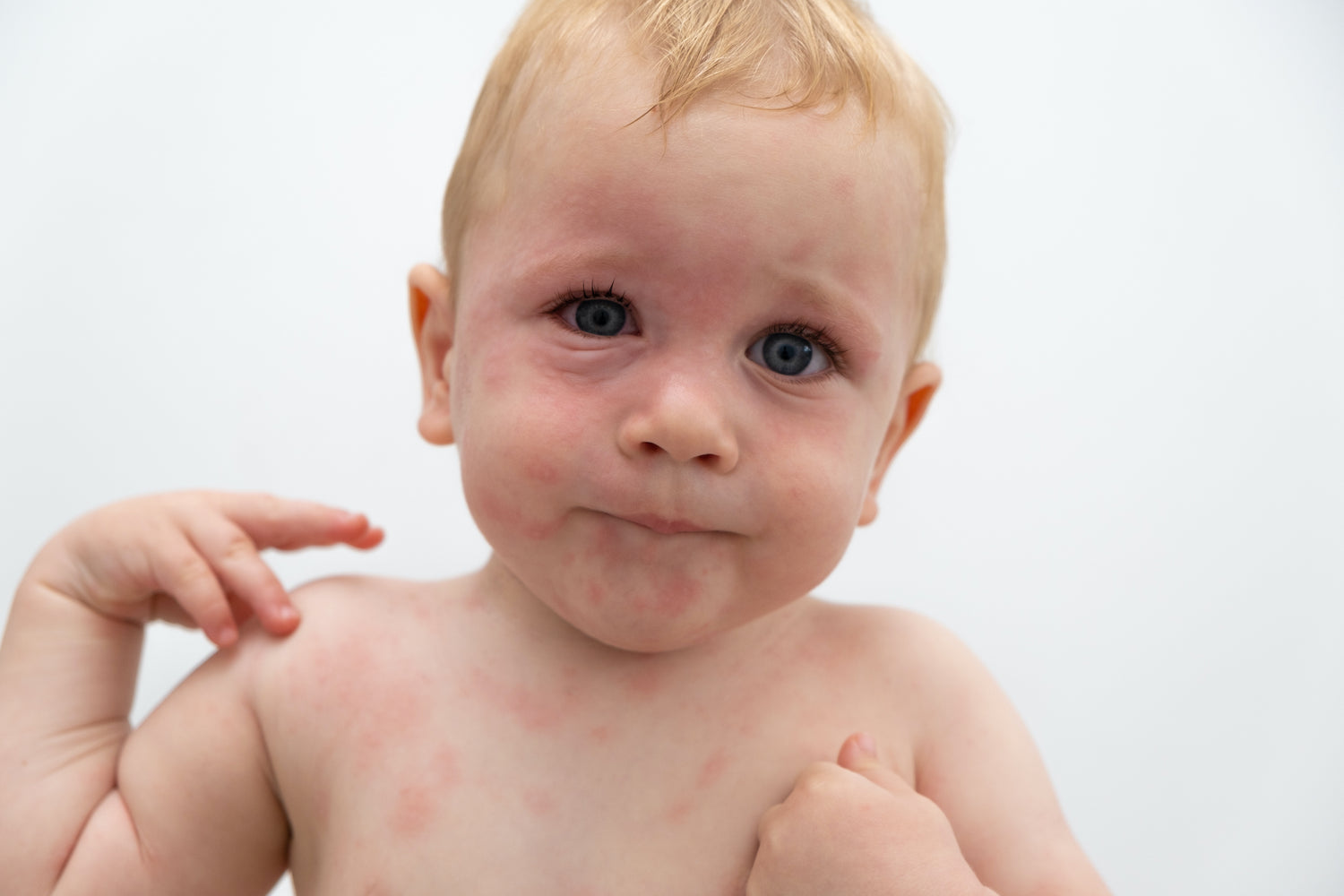Alrighty guys, last week we brought to you the first of two blog write-ups on starting your little one on solid foods. We're hopeful after reading it you're feeling confident and inspired to take on today's part two, which is all about food allergens and how to introduce them, as well as what to do in the event of an allergic reaction.
Of the many fears new parents may have, allergic reactions are often right up there. Unfortunately, navigating allergens and the potential for a reaction to occur is something you do need to think about as your bub meets food for the first time, but the good news is that there's a safe way to go about it. Being equipped with this knowledge should leave you feeling at least a little more ready to embrace this exciting, yet daunting, challenge.
A food allergy occurs when a bub's immune system overreacts to a food that it identifies as a potential threat. An allergic reaction to food is rarely subtle so you will almost certainly know about it if one occurs.
When it comes to introducing allergens there is not yet any clear research on how much of an allergy-causing food a bub needs to prevent them from developing an allergy. What we do know, however, is that an allergy may not present itself until a little one's second or third exposure to the triggering food. Because of this, starting small and gradual with our allergens is the way to go.
When is the best time to start introducing bub to allergens?
The old fashioned advice was to wait until bubs were older, BUT a growing body of evidence tells us the opposite is best.
Did you know that bubs who are introduced to common allergy-causing foods [allergens] BEFORE their first birthday are less likely to develop an allergy to those foods later on!? This means that the process of introducing allergens into their diet will likely commence not long after they've started trying solids. This is super important but please don't let that thought overwhelm you. Make sure your little one is comfortably tolerating some less allergenic foods such as fruits and vegetables before you add in an allergen.
Remember, bub's main source of nutrition will remain breast milk or formula until after their first birthday, so it's okay to go fairly slow.
Food allergies in children have been on the rise however with the new guidelines suggesting introducing allergens before one it's hoped that the number of kiddies developing an allergy will start to decline.
So what are the top ten allergens?
The list below outlines the most common triggers of an allergic reaction to foods.
- Eggs
- Dairy
- Fish
- Peanuts
- Tree Nut
- Wheat
- Soy
- Sesame
- Shellfish - includes crustaceans and molluscs
- Lupin - this is a legume increasingly being used in a wide range of food products including bread, bakery items, pasta, sauces and meat products.
Is my child more at risk of developing a food allergy?
Good question! The answer to this one is that there are a few known risk factors when it comes to allergies. These include:
- Asthma
- Eczema
- Allergic Rhinitis (hayfever)
- Family history of food allergies.
How often should I introduce an allergen?
There is no need to wait 2-3 days between foods, however, we suggest only introducing an allergen on days when you have not introduced any other new food. This is because it would be difficult to ascertain which food caused the reaction if one was to occur.
And what time of day?
We always recommend introducing any new food earlier in the day so that you have daylight hours to observe your bub for any reactions. Most allergic reactions will occur within two hours of eating so once the family has gone to bed and your little one is sleeping it can be difficult to assess them properly. Introduce an allergen and breakfast time and you can usually rest assured that any reaction won't be missed.
Don't forget to keep it up!
Once you introduce an allergen it's important to maintain bub's tolerance to the food by giving it to them regularly. After becoming sure your little one is good to go with a certain food it's a good idea to give it at least twice a week to keep their little bod used to it and reduce their chance of developing an allergy later.
So, what's the difference between an allergy and an intolerance?
There is a common misconception that this is the same thing, but let's debunk that myth. If someone has a food intolerance their digestive system has difficulty processing the food and their symptoms are slower in onset and not life-threatening. A 'food intolerance' does not involve the immune system as an allergy does.
Signs and Symptoms of an Allergic Reaction
When it comes to food allergies the reaction usually occurs within 20 minutes to two hours after eating. When the reaction occurs even more rapidly and has life-threatening characteristics this is what we can anaphylaxis.
Mild to Moderate Signs and Symptoms
- Hives, welts or redness on a bub's body
- Swelling of the mouth, eyes or face
- Vomiting and tummy pain
- Tingling of the mouth
Severe allergic reaction - ANAPHYLAXIS
- Noisy breathing or breathing difficulty
- Tongue swelling
- Hoarse voice or unable to talk
- Tight or swollen throat
- Wheeze or persistence cough
- Dizziness or collapse
- Pale and floppy
What do I do in the event of an allergic reaction?
If the symptoms are severe this is a medical emergency and you need to call 000.
If breathing difficulties are observed call 000.
Regardless of the severity of the food reaction remove the food straight away, wipe bub's face, hands and mouth clean and monitor for worsening of their symptoms.
What about a rash around bub's mouth after acidic foods?
Sometimes lemons, limes, oranges and tomatoes can cause a rash on a bub's face when they come into contact with the acidic juices. This is usually totally harmless and will disappear within minutes after patting the mouth and chin with a wet washer. If your little one has sensitive to acidic foods you can apply a barrier cream around their mouth before mealtimes.
What if my little one is diagnosed with anaphylaxis?
This can be very scary for parents but the key is being informed and prepared. If your little one is prone to severe reactions they will likely be prescribed an epi-pen. This s a medical device in the form of a pre-filled syringe with a drug that reverses anaphylaxis, opening the airways to help with breathing. If this happens in your family make sure that all people caring for your little love, including childcare, know where the epi-pen is located and how to use it.
You will become an expert at reading food labels in no time and there is lots of support available through your maternal child health nurse or GP.
Tiny Hearts Tips on how to offer allergens to your little one:
Eggs: Egg allergies affect almost 10% of bubs under one, but the good news is that most kiddies will outgrow their egg allergy. When introducing egg it's important to separate the egg white from the yolk and try the yolk first. Once you know bub is okay with the yolk you can try the white another day, before then giving whole eggs next time. Our tip is to scramble the egg or mash some hard-boiled egg into in a fruit or veggie puree.
Dairy: You can trial dairy by offering a small amount of plain yoghurt or custard to your little one's fruit or cereal. Smooth ricotta is another good option.
Wheat: Semolina porridge can be mixed with breastmilk or formula. You can also try baby-led-weaning style toast sticks.
Fish: Steam boneless white fish and finely shred it before adding to pureed vegetables. You can also mash into avocado to form grabbable clumps. The most common fish to cause allergies are tuna and salmon so start with other fish first. Be careful of fish bones. Sardines also make great food for your bub, and although many of us adults dislike the idea, babies often LOVE them!
Shellfish: Make sure any seafood is well cooked. Finely chop or dice shellfish and incorporate into a moist of stick food such a mashed potato, avocado or rice.
Peanuts and Tree nuts: When introducing nuts to bubs do so with a smooth nut butter containing only one type of nut. The best kind to use is free from added sugars, salts and oils. Avoid whole nuts as these are a choking hazard! Nut butters can be first introduced by popping a small amount of the butter inside bub's lip. If there's no reaction after a few mins you can add a little to bub's regular foods.
Sesame: This is the main ingredient in tahini so try offering bub some tahini paste mixed into their vegetables or spread on other safe foods you've tried.
Soy: You can mash tofu into puree or offer sticks baby-led-weaning style.
Lupins: These can be purchased in a can and blitzed into a paste to add to bub's meat or vegetables.
So there you have it; Our two-part solids and allergy write-up covered for you across the blog! If you have missed part one, please click here to read.








